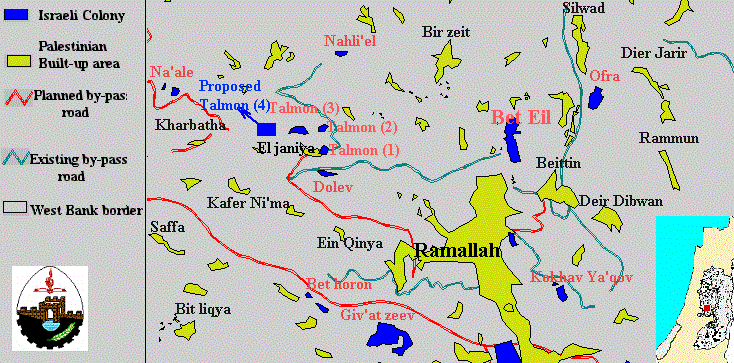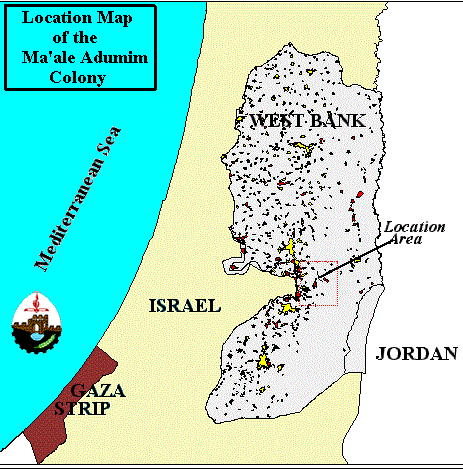El Janiya village is one of the rural communities in Palestine spreading over 25,000 dunums of land. It is located west of Ramallah city with a population of approximately 827. El Janiya village is surrounded by several small communities which depend mainly on agriculture and livestock for living ( Figure 1) .) .
Figure 1: Location Map of El Janiya village
The Israeli colonization in El Janiya village started as early as 1983. Presently, five Israeli colonies, namely Dolev, Talmon-1, Talmon-2, Talmon-3 (Figure 2), and the under construction settlement Talmon-4, have been established in the eastern parts of the village. The total pouplation of the five Israeli colonies reaches approximately 1200 of ultra-orthodox Jews (Figure 3). About 20,000 dunums of the village best agricultural lands were lost for the construction of these colonies. Lands were confiscated under the pretext of being 'state -owned land'.
Figure 2: Strangulation of the eastern part of El Janiya village
Figure 3: Photo illustrating the new outpost
Talmon-4 is merely an extension of the Talmon settlement, about a kilometer away. It is planned that Talmon-1, -2, -3, and -4 will form a single built-up area surrounding the valley of olive trees cultivated by Palestinian villagers. The Israeli bulldozers have almost completed leveling the ground for the new outpost which consists of two families, four caravans, a water tank, and a guard post . It is one of 20 new outposts created since signing Wye River Memorandum.
|
Table1: Israeli Settlements Constructed on El Janiya Land |
||||||
|
Israeli Settlement |
Number of |
Founding |
Population |
Empty Housing |
Units under |
Built-up Area |
|
Dolev |
118 |
Jan-83 |
Religious |
11 |
24 |
225 |
|
Talmon-1,-2,-3 ,-4 |
120 |
Mar-89 |
Religious |
47 |
27 |
469 |
A little further, bulldozers shuttle to and fro clearing the ground for the new road which will bypass the neighboring Palestinian villages, to enable the colonists living in the four sectors of Talmon to get to Jerusalem in half an hour. For the construction of that road, colonists uprooted more than 500 trees (Figure 4).
Figure 4: Construction of a new by-pass road
Lands used for the construction of these colonies and several settlement roads are located within the village boundary of El Janiya. They are also part of the main rangelands in El Janiya which provide feed for livestock. The closure of these lands not only deprives the Palestinians of a major source of income, but also threatens the biodiversity in that area. The construction of these colonies has also affected the growth of Palestinian communities in the eastern direction. Presently, only 500 dunums of the total area of El Janiya village are left for population natural growth.
It is of important weight to mention that waste water generated from Israeli colonies flows into the nearby valleys and damages the agricultural lands which belong to El Janiya village (Figure 5).
Figure 5: Affected Palestinian Agricultral land
Settlement construction in the Occupied Territories continues to go before and after Israel's general elections (May 17th 1999) which to a large extent has a decisive influence on creating facts on the ground before a final agreement with the Palestinians on the status of the area.
Prepared by:
The Applied Research Institute – Jerusalem



















